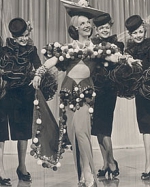Carmen Miranda
Carmen Miranda was a Portuguese-born Brazilian samba singer, Broadway actress and Hollywood film star popular in the 1940s and 1950s. She was, by some accounts, the highest-earning woman in the United States and recognized for her signature fruit hat outfit that she wore in the 1943 movie The Gang’s All Here. She is considered the precursor of Brazil’s Tropicalismo.
Carmen Miranda was born in Várzea da Ovelha, a village in the northern Portuguese municipality of Marco de Canaveses. She was the second daughter of José Maria Pinto Cunha and Maria Emília Miranda. When she was 10-months old, her father emigrated to Brazil and settled in Rio de Janeiro, where he opened a barber’s shop. Her mother followed in 1910, together with her daughters Olinda and Maria do Carmo. Maria do Carmo never returned to Portugal, but retained her Portuguese nationality. In Brazil, her parents had four more children – Amaro, Cecília, Aurora and Óscar. She was christened Carmen by her father because of his love for the opera comique, and also after Bizet’s masterpiece Carmen. This passion for opera influenced his children, and Miranda’s love for singing and dancing at an early age. She went to school at the Convent of Saint Therese of Lisieux. Her father did not approve of her plans to enter show business. However, her mother supported her and was beaten when her husband discovered Carmen had auditioned for a radio show. Carmen had previously sung at parties and festivals in Rio. Her older sister Olinda contracted tuberculosis and was sent to Portugal for treatment. Miranda went to work in a tie shop at age 14 to help pay her sister’s medical bills. She next worked in a boutique, where she learned to make hats and opened her own hat business which became profitable.
Her extraordinary talent was discovered when Miranda was first introduced to composer Josué de Barros, who went on to promote and record her first album with a Brunswick, a German recording company in 1929. In 1930, she was known to be Brazil’s gem singer, and in 1933 went on to sign a two-year contract with Rádio Mayrink Veiga – becoming the first contract singer in the radio industry history of Brazil. In 1934, she was invited as a guest performer in Radio Belgrano in Buenos Aires. Ultimately, Miranda wound up with a recording contract with RCA Records. She pursued a career as a samba singer for ten years before she was invited to New York City to perform in a show on Broadway. As with other popular singers of the era, Miranda made her screen debut in the Brazilian documentary A Voz Do Carnaval. Two years later, Miranda appeared in her first feature film entitled Alô, Alô Brasil. But it was the 1935 film Estudantes that seemed to solidify her in the minds of the movie-going public. In the 1936 movie Alô Alô Carnaval, she performed the famous song Cantoras do Rádio with her sister Aurora, for the first time.


